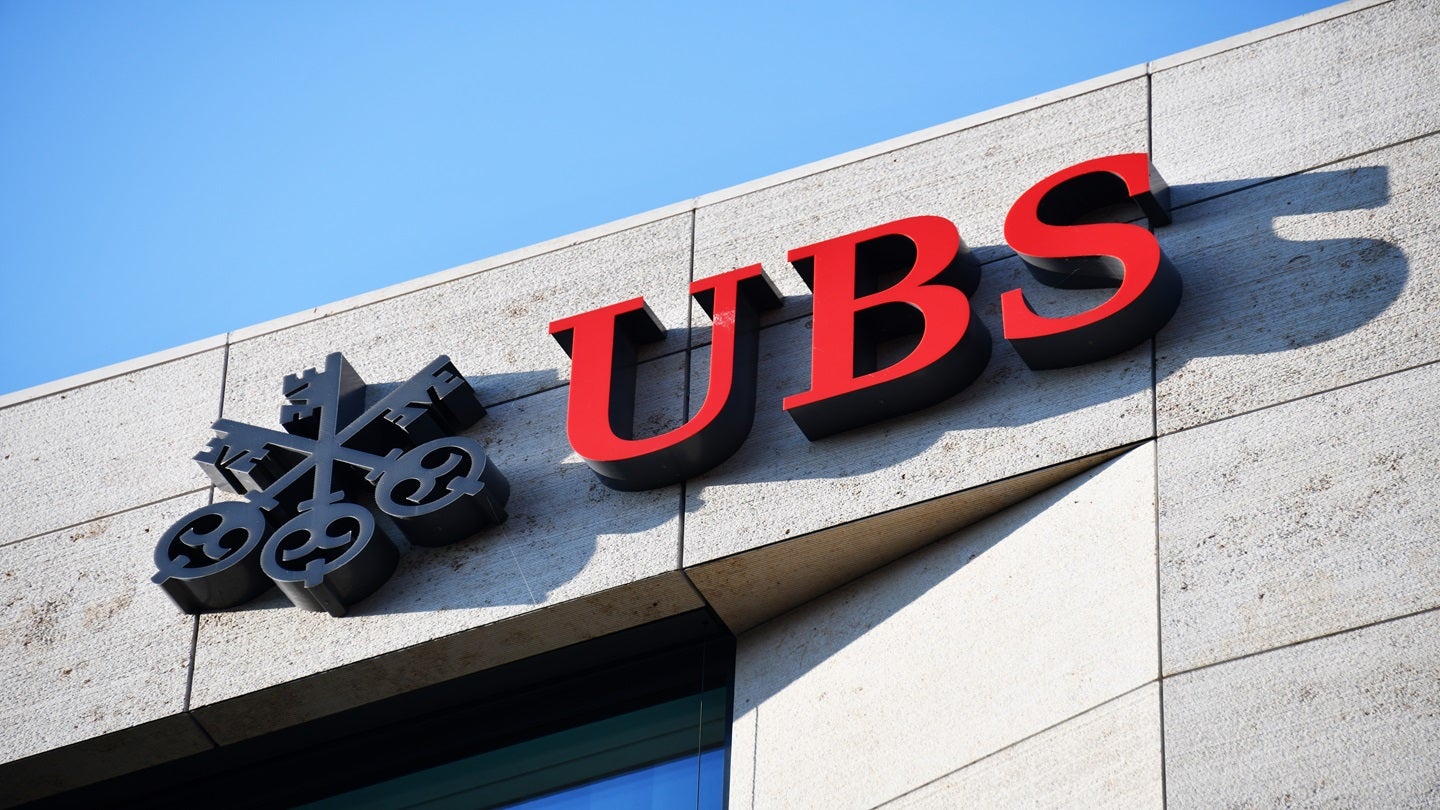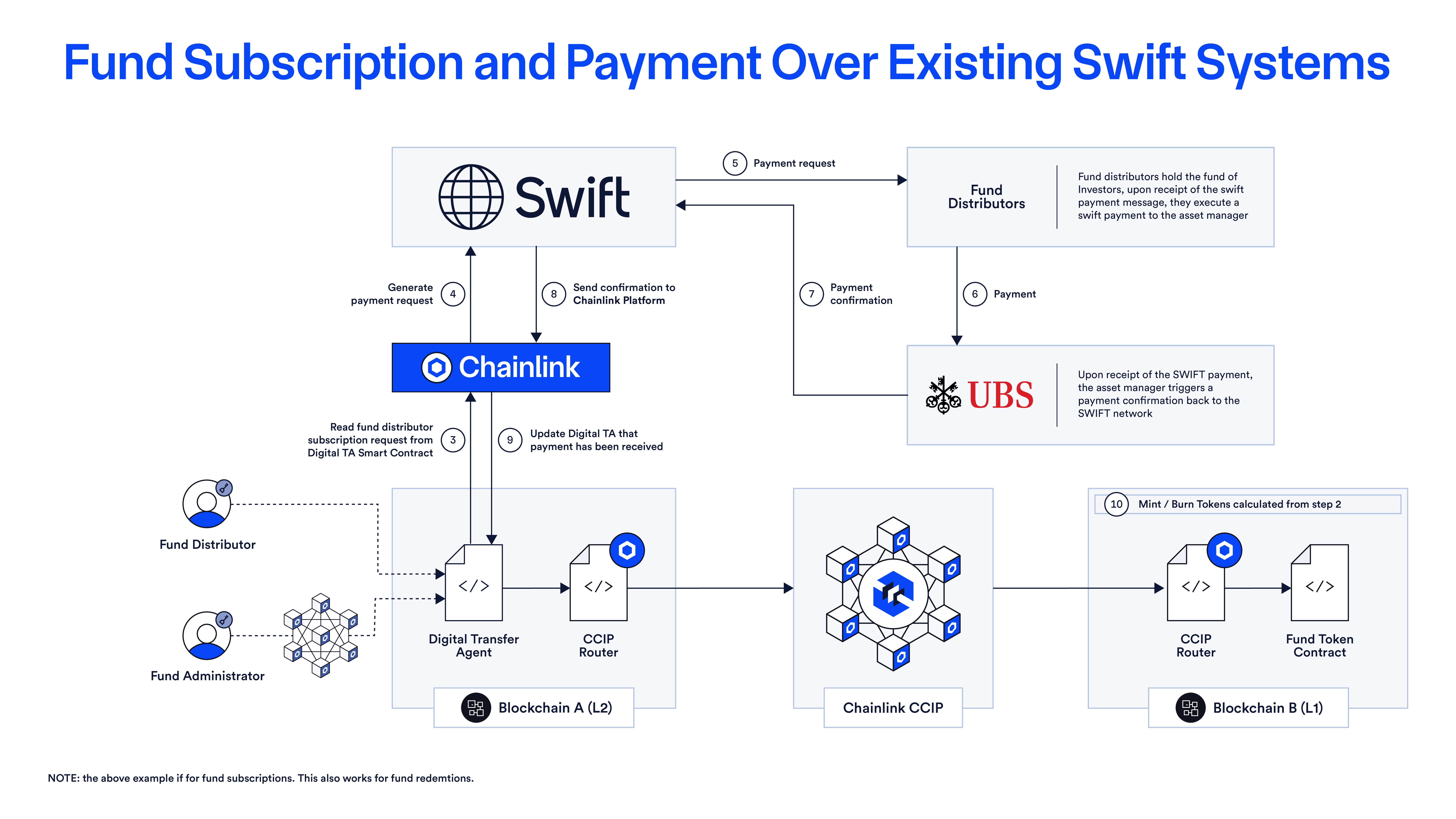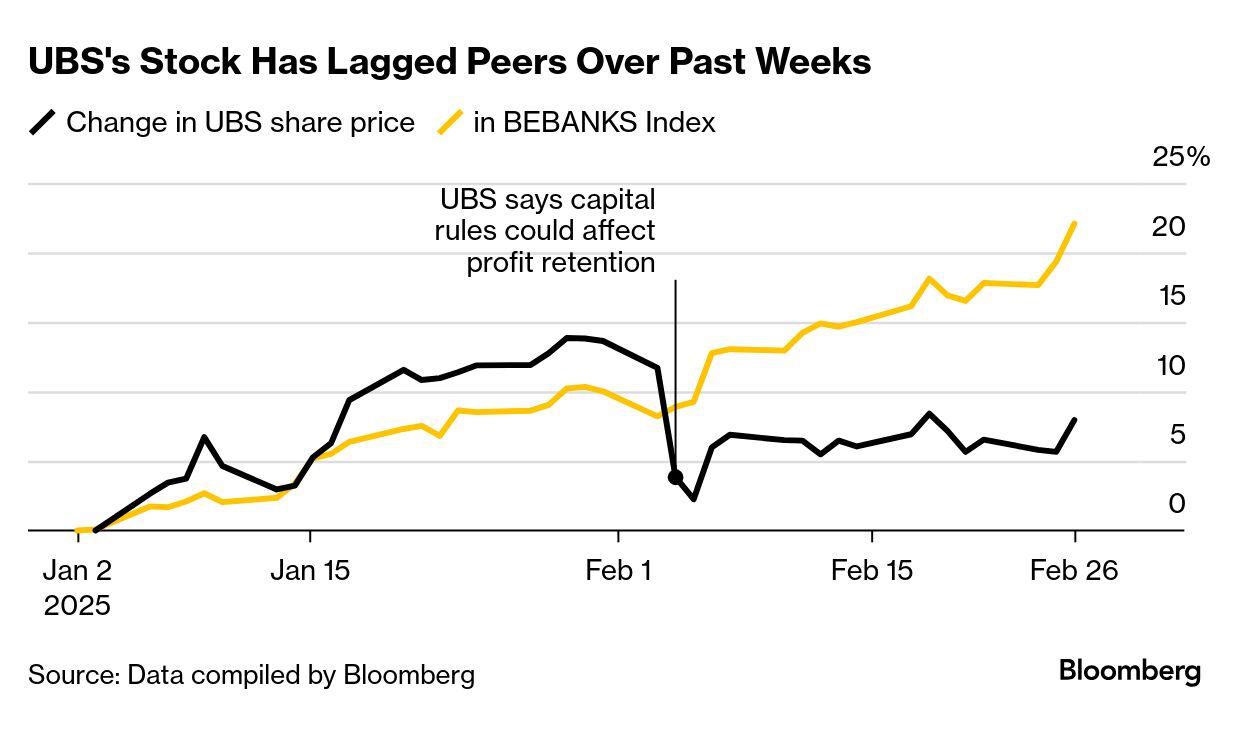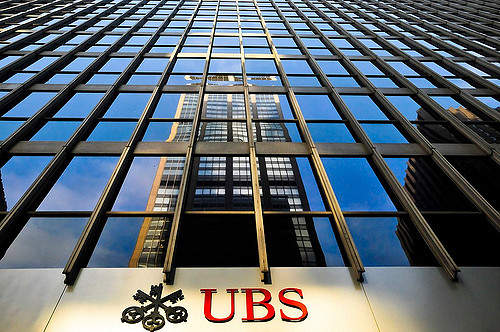Main Issue: UBS is pushing back against Swiss government proposals that would significantly increase the bank’s capital requirements, arguing they’re disproportionate and not aligned with international standards.
Financial Impact: The proposed changes would require UBS to hold an additional $24 billion in Common Equity Tier 1 (CET1) capital, primarily due to a $23 billion deduction related to foreign subsidiary investments. Combined with the $18 billion already needed from the Credit Suisse acquisition, the total additional capital requirement would reach $42 billion.
Key Changes Proposed:
- Full deduction of investments in foreign subsidiaries from CET1 capital
- Dedication of deferred tax assets on temporary differences
- Dedication of capitalized software
- Increased prudential valuation adjustments
Impact on Ratios: While UBS’s CET1 capital ratio would rise to 19% at the group level, the regulatory measures could effectively reduce it to around 17% due to misalignment with global standards.

UBS’s Position: Despite these regulatory challenges, the bank maintains its financial targets, including a 15% return on Common Equity Tier 1 (CET1) capital and keeping the cost-to-income ratio below 70% by the end of 2026. They’re also proceeding with a 2025 capital return plan, including a 10% dividend increase and up to $3 billion in share repurchases.
This appears to be part of the ongoing regulatory response following UBS’s acquisition of Credit Suisse, with Swiss authorities looking to strengthen banking oversight. At the same time, UBS argues for more internationally consistent standards.
UBS’s Motivation for Challenging Capital Requirements
Financial Impact: UBS’s primary motivation is the massive $42 billion total additional capital requirement, comprising $24 billion from the new Swiss proposals and $18 billion already needed from the Credit Suisse acquisition. This represents a substantial financial burden that would significantly impact the bank’s profitability and return on equity.
Competitive Disadvantage: UBS argues these requirements are “neither proportionate nor internationally aligned,” creating an uneven playing field where Swiss banks face stricter rules than global competitors. This could handicap UBS in international markets where it competes with banks operating under less stringent capital regimes.
Operational Constraints: The proposed CET1 ratio of 19% (effectively 17% under regulatory adjustments) is substantially higher than most international standards, which may limit UBS’s ability to deploy capital efficiently for growth and investment opportunities.
Bank Capital Risk Analysis
Systemic Risk Mitigation: The Swiss proposals aim to prevent another Credit Suisse-style collapse by ensuring banks have sufficient capital buffers. Higher capital requirements reduce the probability of bank failure and potential taxpayer bailouts.
“Too Big to Fail” Problem: Swiss regulators aim to “strengthen the capital base and improve resolvability.” Higher Capital Rules Loom for Systemically Important Banks, such as UBS, which has become even more systemically crucial after absorbing Credit Suisse.
Risk vs. Returns Trade-off: While higher capital requirements enhance financial stability, they also reduce banks’ return on equity and may limit lending capacity, potentially affecting economic growth.
Impact on Singapore
Direct Operations: UBS operates in Singapore through UBS Securities Singapore Pte. Ltd. and UBS AG, Singapore Branch, providing both investment banking and wealth management services. Higher capital requirements could affect the bank’s ability to expand these operations or compete aggressively in the Singapore market.
Regulatory Alignment: Singapore is implementing Basel 3.5 standards, set to take full effect in 2025, as outlined in the Banking Laws and Regulations 2025 | Singapore. This indicates that the Monetary Authority of Singapore (MAS) is also strengthening capital requirements. However, Singapore’s approach appears more aligned with international standards than the Swiss proposals.
Wealth Management Hub: Singapore serves as UBS’s key Asian wealth management hub. If UBS faces capital constraints, it might reduce its investment in Singapore operations or become less competitive against local banks and other international players in the lucrative Asian private banking market.
Historical Context: Singapore’s Government Investment Corporation previously invested $9.7 billion in UBS during the 2007 financial crisis, as noted on the UBS Wikipedia page, highlighting the interconnected relationship between UBS and Singapore’s financial ecosystem.
Competitive Landscape: Higher capital requirements for UBS could create opportunities for Singapore-based banks or other international banks with more favourable regulatory treatment to gain market share in the region.
The outcome of UBS’s challenge will likely influence how other jurisdictions, including Singapore, balance financial stability with maintaining competitive banking sectors. Singapore’s approach of aligning with international Basel standards while maintaining its attractiveness as a financial hub appears more balanced than the stricter Swiss proposals.

In-Depth Analysis: Capital Requirement Increases and UBS’s Global Market Position
Executive Summary
UBS faces unprecedented regulatory pressure from Swiss authorities, who are proposing capital requirements that could amount to $42 billion in additional Common Equity Tier 1 (CET1) capital. This regulatory burden threatens to fundamentally alter the bank’s competitive position in global markets. This analysis examines how these requirements could hinder UBS’s competitiveness relative to international peers, explores similar risks faced by other systemically important banks, and assesses the specific implications for Singapore’s financial ecosystem.

The Regulatory Landscape: A Tale of Diverging Standards
Swiss Exceptionalism vs. Global Standards
The proposed Swiss capital requirements represent a significant departure from international Basel III standards, creating, according to UBS, a proportionate” regulatory framework. While Basel III establishes minimum CET1 ratios of 4.5% plus a 2.5% conservation buffer (totalling 7%), Swiss regulators are effectively pushing UBS toward a 19% CET1 ratio—nearly three times the international minimum.
This divergence becomes more pronounced when compared to the Global Systemically Important Bank (G-SIB) framework. Under current international standards, G-SIBs face additional capital surcharges ranging from 1% to 3.5% based on their systemic importance bucket. UBS, as a Global Systemically Important Bank (G-SIB), already faces these enhanced requirements, making the Swiss proposals particularly burdensome.
The Credit Suisse Integration Factor
The $18 billion in additional capital requirements stemming from the Credit Suisse acquisition, combined with the proposed $24 billion from new regulations, creates a perfect storm of capital constraints. This $42 billion total represents approximately the current market capitalization, underscoring the significant impact of regulatory changes on shareholder value.
Competitive Handicap Analysis: UBS vs. Global Peers
Return on Equity Erosion
The most immediate competitive disadvantage emerges in return on equity (ROE) metrics. With an additional $42 billion in CET1 capital requirements, UBS faces significant pressure to meet its target return on equity (ROE) of 15%. Assuming current profit levels, this capital increase could reduce the return on equity (ROE) by approximately 300-400 basis points, placing UBS at a substantial disadvantage compared to peers operating under more lenient regulatory regimes.

Cost of Capital Implications
Higher capital requirements translate directly into increased funding costs. While equity capital provides a safety buffer, it’s also the most expensive form of funding for banks. UBS’s weighted average cost of capital will inevitably rise, making it more challenging to compete on pricing in corporate lending, investment banking fees, and wealth management services.
Market Share and Growth Constraints
The capital constraints create a vicious cycle where UBS may be forced to:
- Reduce balance sheet growth to preserve capital ratios
- Exit specific business lines or geographic markets
- Increase pricing to compensate for higher capital costs
- Potentially lose market share to more nimble competitors
Geographic Arbitrage Risks
International banks operating in jurisdictions with more aligned Basel III implementation may gain competitive advantages in shared markets. For example, European banks operating under the EU Capital Requirements Regulation (CRR) or US banks under Federal Reserve guidelines may find themselves better positioned to compete against UBS in Asian markets, such as Singapore.
Comparative Analysis: Similar Bank Risks and Regulatory Responses
European Banking Union Response
European regulators have taken a more measured approach to post-crisis banking regulation. The European Banking Authority (EBA) has implemented Basel III requirements while maintaining alignment with international standards. Central European banks, such as BNP Paribas, Deutsche Bank, and Credit Agricole, face G-SIB surcharges but operate under more predictable regulatory frameworks than UBS’s proposed Swiss regime.
US Banking Resilience
US banks faced their own regulatory tightening through the Comprehensive Capital Analysis and Review (CCAR) and the Dodd-Frank stress testing requirements. However, recent discussions around the implementation of Basel III’s “Endgame” in the US have shown more flexibility than the Swiss proposals. JPMorgan Chase, Bank of America, and Citigroup, despite being the largest Global Systemically Important Banks (G-SIBs) globally, operate under capital requirements that, while stringent, remain internationally competitive.
Asian G-SIB Comparisons
Asian G-SIBs, including ICBC, China Construction Bank, Agricultural Bank of China, and Bank of China, operate under Chinese regulatory frameworks that, while strict, don’t impose the same level of capital intensity as proposed Swiss regulations. This creates particular competitive concerns for UBS in Asian markets where these banks are expanding aggressively.
UK Banking Sector Lessons
The UK has emphasized maintaining international competitiveness post-Brexit, while ensuring financial stability. Banks like HSBC and Barclays operate under Prudential Regulation Authority (PRA) rules that, while robust, avoid the extreme positions seen in Swiss proposals. This balanced approach has helped maintain London’s position as a global financial centre.
Singapore: The Strategic Nexus of Competitive Impact
UBS Singapore Operations: Current Footprint
UBS operates in Singapore through multiple entities, with UBS AG Singapore Branch and UBS Securities Singapore Pte. Ltd. serving as key platforms for wealth management and investment banking activities, respectively. Singapore represents UBS’s primary Asian wealth management hub, managing assets for ultra-high-net-worth individuals across the region.
The bank’s Singapore operations are particularly significant given the city-state’s role as Asia’s premier private banking centre. With over S$4 trillion in assets under management across the industry, Singapore’s wealth management sector represents a critical battleground for global banks.

Regulatory Environment in Singapore
The Monetary Authority of Singapore (MAS) has implemented Basel III requirements, with a focus on maintaining Singapore’s competitiveness as a financial hub. MAS’s approach emphasizes risk-based supervision, ensuring alignment with international regulatory standards. Singapore banks and foreign bank branches must maintain minimum capital adequacy ratios of 10% for locally incorporated banks and higher requirements for systemically important institutions.
However, Singapore’s regulatory framework remains more aligned with international standards than the proposed Swiss regime, creating potential competitive advantages for other international banks operating in the market.
Competitive Landscape Implications
Wealth Management Market Dynamics
UBS’s dominant position in Asian wealth management could face significant challenges:
- Private Banking Competition: European competitors, such as Credit Suisse (pre-acquisition), Deutsche Bank’s private bank, and BNP Paribas Wealth Management, may gain market share if UBS becomes less competitive in pricing or service offerings due to capital constraints.
- Regional Players: Singapore-based banks like DBS and UOB, along with other Asian private banks, could benefit from UBS’s potential retreat from aggressive market expansion.
- US Bank Expansion: American banks with strong capital positions and more favourable regulatory treatment may accelerate their Asian expansion plans, particularly in the high-margin private banking sector.
Investment Banking Services
UBS’s investment banking operations in Singapore serve as a regional hub for:
- IPO underwriting and equity capital markets
- Debt capital markets and structured products
- M&A advisory services
- Trading anmarketts activities
Capital constraints could force UBS to:
- Reduce trading book sizes, limiting market-making capabilities
- Become more selective in underwriting commitments
- Increase fees to compensate for higher capital costs
- Potentially exist specific product lines or client segments
Economic Impact on Singapore’s Financial Sector
Market Concentration Concerns
Singapore’s wealth management industry benefits from competition among global banks. If UBS’s competitive position weakens significantly, it could lead to:
- Reduced innovation in wealth management products
- Higher fees for clients as competition decreases
- Potential market concentration among the remaining players
Talent and Employment Effects
UBS employs significant numbers of high-skilled professionals in Singapore across:
- Relationship management and client advisory
- Investment research and portfolio management
- Risk management and compliance
- Technology and operations
Reduced competitiveness might lead to:
- Slower hiring or potential job cuts
- Brain drain to competitors with stronger market positions
- Reduced investment in Singapore-based technology and infrastructure
Financial Ecosystem Implications
Singapore’s position as a financial hub depends on the presence of strong international banks. UBS’s diminished competitiveness could:
- Reduce Singapore’s attractiveness to international investors
- Limit the city-state’s ability to compete with Hong Kong and other regional centres
- Impact related service industries, including legal, accounting, and consulting services
Strategic Response Options and Scenarios
UBS Strategic Alternatives
- Regulatory Arbitrage: UBS may consider relocating certain operations to jurisdictions with more favourable regulatory treatment, although this would be a complex and costly optimization
- Business Model Optimization Focus on higher-margin, lower-capital-intensive businesses, such as wealth management, while reducing capital-intensive trading and corporate banking activities.
- Strategic Partnerships: Form alliances with regional banks or fintech companies to maintain market presence without full capital deployment.
- Legal and Political Advocacy: Continue challenging Swiss regulations through legal channels and political lobbying, potentially seeking European Union intervention.
Regulatory Response Scenarios
Scenario 1: Full Implementation
If Swiss authorities implement the complete proposed capital requirements:
- UBS faces a fundamental competitive disadvantage
- Significant market share loss likely in Asia-Pacific
- Potential strategic retreat from specific markets
- Singapore wealth management market opens to increased competition
Scenario 2: Negotiated Compromise
A more likely scenario involving:
- Reduced capital requirements through negotiation
- Phased implementation over a longer timeline
- Some alignment with international standards
- UBS maintains a competitive position, but with constraints
Scenario 3: Regulatory Reversal
Less likely but possible:
- Swiss authorities scale back proposals significantly
- International pressure leads to a more aligned approach
- UBS maintains current competitive dynamics
- Singapore operations continue normal expansion
Long-term Implications for Global Banking
Regulatory Fragmentation Risks
The UBS case highlights the growing regulatory fragmentation in global banking, with a focus on prioritizing domestic financial stability over international competitiveness. This trend could lead to:
- Reduced efficiency in global capital allocation
- Increased compliance costs for international banks
- Potential balkanization of global financial markets
- Competitive distortions based on regulatory jurisdiction rather than business fundamentals

Systemic Risk Considerations
While higher capital requirements reduce individual bank failure risks, extreme regulatory positions may create new systemic risks:
- Concentration of banking activities in less-regulated jurisdictions
- Potential reduction in banking services in over-regulated markets
- Increased reliance on shadow banking systems
- Unintended consequences for financial stability
Conclusions and Recommendations
The proposed Swiss capital requirements pose a fundamental challenge to UBS’s global competitiveness, with particularly significant implications for its Asian operations, particularly those centred in Singapore. The bank faces a complex balancing act between regulatory compliance and market competitiveness that will likely reshape its strategic priorities for years to come.

For Singapore, the outcome of this regulatory battle has important implications for maintaining its position as Asia’s premier financial centre. Policymakers should closely monitor developments and consider whether adjustments to local regulatory frameworks are necessary to maintain a competitive balance in the wealth management and investment banking sectors.
The UBS situation serves as a cautionary tale about the risks of regulatory divergence in a globally interconnected financial system. While the intentions behind heightened capital requirements are laudable, their implementation must strike a balance between financial stability objectives and the need to maintain competitive and efficient global banking markets.
Ultimately, the resolution of UBS’s regulatory challenges will provide important lessons for other jurisdictions grappling with similar tensions between domestic financial stability and international competitiveness in their banking sectors.
The Unravelling: A Singapore Witness to UBS’s Fall
Chapter 1: The Golden Years
Mei Lin Tan adjusted her silk scarf as she stepped out of the black Mercedes onto Robinson Road, the humid Singapore morning already promising another scorching day. At thirty-eight, she had spent the last twelve years climbing the ranks at UBS’s Singapore wealth management division, watching the Swiss banking giant transform Marina Bay into its Asian empire.

From her corner office on the forty-second floor of One Raffles Quay, Mei Lin commanded a panoramic view of the Singapore Strait. Ships dotted the horizon like floating cities, carrying cargo and capital that flowed through Singapore’s veins. It was from this perch that she had witnessed UBS’s meteoric rise in Asian private banking, managing over $180 billion in regional assets under management.
“Another record quarter,” her assistant, Jonathan, announced as he placed the morning briefings on her mahogany desk. The numbers were staggering—UBS Singapore had just closed $4.2 billion in new asset inflows, primarily from Indonesian palm oil magnates and Chinese tech entrepreneurs seeking safe havens for their wealth.
Mei Lin smiled, remembering her early days when UBS Singapore was merely a footnote in the global private banking landscape. Now, they were the undisputed champions of Asian wealth management, having systematically dismantled Credit Suisse’s Asian operations even before the dramatic acquisition in 2023.
Her phone buzzed with a message from her largest client, Richard Lim, the Singaporean shipping tycoon whose family controlled nearly $800 million through UBS. “Mei Lin, exceptional work on the structured product. Looking forward to expanding our portfolio next quarter.”
Those were the golden days, when UBS’s balance sheet seemed limitless, when capital flowed like Singapore’s monsoon rains, and when her bonus checks reflected the bank’s insatiable appetite for growth.
Chapter 2: The First Tremors
The first sign of trouble arrived on a Tuesday morning in March 2025, buried in the second paragraph of a Reuters alert on Mei Lin’s Bloomberg terminal. Swiss financial regulators had proposed new capital requirements following the integration of Credit Suisse. The numbers seemed abstract—$42 billion in additional CET1 capital, ratios climbing to 19%.
“Just regulatory theatre,” dismissed Marcus Weber, UBS Singapore’s country head, during their weekly leadership meeting. The German banker had arrived in Singapore five years earlier, confident in UBS’s ability to navigate regulatory hurdles. “We’ve weathered Basel III, Dodd-Frank, and MiFID II. This is just another box to check.”

But Mei Lin noticed subtle changes in the weeks that followed. Credit approvals that once took days now require weeks. Trading limits were quietly reduced. The bank’s legendary willingness to finance complex structured products began to wane.
Her first real alarm came during a client meeting with the Tan family, Singaporean real estate developers seeking to finance a $500 million mixed-use project in Jakarta. UBS had historically been their go-to bank for such ventures, offering competitive rates and creative structuring.
“I’m sorry, Mrs. Tan,” Mei Lin found herself saying, her voice catching slightly. “We’re experiencing some internal policy adjustments. Perhaps we could explore a smaller facility, or consider bringing in a syndicate partner?”
Mrs. Tan’s expression shifted from surprise to disappointment. “Mei Lin, we’ve banked with UBS for fifteen years. If you can’t provide the same service, we’ll have to explore other options.”
That afternoon, Mei Lin learned that DBS had swooped in with a full $500 million facility at terms UBS couldn’t match. It was the beginning of what she would later recognize as the great unravelling.
Chapter 3: The Exodus Begins
By June 2025, the Swiss regulatory noose was tightening. UBS’s share price had declined 23% since the capital requirement proposals, and the bank’s return on equity projections looked increasingly dire. In Singapore, the effects were becoming impossible to ignore.
“We need to discuss your portfolio strategy,” Mei Lin told Richard Lim during what would be their final client meeting. Across the table, the shipping magnate’s expression hardened as she explained UBS’s new restrictions on leverage, its increased fees for complex products, and its reduced appetite for emerging market exposures.
“You’re telling me that the bank that built its reputation on sophisticated Asian wealth management can no longer provide sophisticated Asian wealth management?” Richard’s voice carried the edge of a man accustomed to getting what he wanted.
Mei Lin had no good answer. Behind the euphemisms about “strategoptimizationning” and “risk optimization”, the truth was stark: UBS was being choked by capital requirements that its competitors didn’t face.
Within a month, Richard had transferred his $800 million relationship to HSBC. He wasn’t alone. The Indonesian palm oil families moved to Credit Agricole’s Singapore office. The Chinese tech entrepreneurs discovered that JPMorgan could offer everything UBS once provided, but with better terms and fewer restrictions.
Marcus Weber tried to maintain optimism during town halls, but his explanations grew increasingly hollow. “We’re focusing on quality over quantity,” he insisted, even as the Singapore office’s assets under management declined by $23 billion in the second quarter of 2025.
Chapter 4: The Talent Drain
The first senior departure came in August. David Chen, the head of investment products at UBS Singapore, announced that he was joining Goldman Sachs’ private wealth division. His farewell email was diplomatically brief, but everyone understood the subtext: Goldman could offer clients what UBS could no longer.
“David’s leaving?” asked Priya Sharma, one of Mei Lin’s top relationship managers, during their morning briefing. “That’s the third senior banker this month.”
The talent exodus accelerated as UBS’s constraints became more apparent. Singapore’s financial sector was small and tightly networked—word spread quickly when a global bank could no longer compete effectively. Headhunters circled like vultures, offering UBS bankers opportunities at institutions unencumbered by Swiss regulatory overkill.
Mei Lin found herself in an impossible position. Her clients were leaving for competitors who could offer superior terms, her colleagues were jumping ship for better opportunities, and her own performance metrics were plummeting through no fault of her own.
The final straw came during a recruitment dinner with potential hires from rival banks. “Why would I join UBS Singapore?” a senior private banker from Citigroup asked. “Everyone knows you’re capital-constrained. My clients want a bank that can grow with them, not one that’s shrinking.”
Chapter 5: The Reckoning
By November 2025, the statistics were undeniable. UBS Singapore’s assets under management had fallen to $127 billion, down from $180 billion at the start of the year. The bank’s market share in Asian private banking had dropped from 12% to 8%, with DBS, HSBC, and JPMorgan the primary beneficiaries.
Mei Lin sat in her office on a grey Thursday evening, the Singapore skyline blurred by another tropical downpour. The latest client report lay open on her desk—another $200 million relationship lost to Bank of Singapore, which had aggressively recruited former UBS clients with competitive pricing and expanded service offerings.
Her phone rang. Marcus Weber’s voice was unusually subdued. “Mei Lin, I need you in my office.”
The conversation was brief and devastating. UBS was restructuring its Asian operations, consolidating functions in Singapore and Hong Kong, and reducing headcount by 35%. Mei Lin’s division would be merged with the institutional banking division, and her role would be eliminated.
“It’s not personal,” Marcus assured her, though his own future remained uncertain. “The regulatory environment has fundamentally changed our operating model. We’re adapting as best we can.”
Chapter 6: Aftermath
Six months later, Mei Lin watched from her new office at DBS as UBS Singapore struggled through another round of departures. The Swiss bank’s gleaming headquarters still dominated the Marina Bay skyline, but its influence had waned dramatically.
Her former colleagues are scattered across Singapore’s financial district. Some joined local banks that had grown stronger as UBS weakened. Others moved to American or European institutions that could still deploy capital aggressively in Asian markets. A few left banking entirely, casualties of regulatory overreach they couldn’t control.
The broader implications rippled through Singapore’s financial ecosystem. With UBS’s diminished competitive presence, the city-state’s position as Asia’s private banking hub faced new challenges. Hong Kong’s wealth managers, operating under different regulatory constraints, have begun poaching Singapore-based clients with renewed vigour.
“It’s ironic,” Mei Lin reflected during lunch with Priya, who had also landed at DBS. “Swiss regulators wanted to make their banking system safer, but they ended up making Swiss banks irrelevant in the world’s fastest-growing wealth markets.”
Epilogue: The New Order
Two years after the great unwinding began, Singapore’s private banking landscape had undergone permanent changes. UBS remained present but diminished, a shadow of its former self. Local banks, such as DBS and UO, had gained market share, while American and other European banks filled the void left by Swiss regulatory overreach.
Mei Lin, now head of North Asia Private Banking at DBS, often reflects on the lessons learned. In global finance, regulatory nationalism could be as destructive as market failures. The Swiss authorities had achieved their goal of making UBS safer, but at the cost of making it irrelevant in the markets that mattered most for future growth.
From her new office in Marina Bay Financial Centre, Mei Lin could see UBS’s headquarters across the water. The building remained impressive, but the empire it once housed had crumbled under the weight of the regulatory burden that its competitors never faced.
In Singapore’s pragmatic approach to financial regulation—balancing stability with competitiveness—lay perhaps the real lesson of UBS’s decline. The city-state had prospered by creating conditions that allowed global banks to thrive while maintaining appropriate oversight. It was a balance that Swiss regulators, in their zeal for absolute safety, had failed to achieve.
The golden age of UBS in Asia was over, not because of market forces or strategic missteps, but because regulators in Bern had forgotten that in global finance, unilateral disarmament is often indistinguishable from surrender.
In-Depth Analysis: Capital Requirement Increases and UBS’s Global Market Position
Executive Summary
UBS faces unprecedented regulatory pressure from Swiss authorities, who are proposing capital requirements that could reach $42 billion in additional CET1 capital—a regulatory burden that threatens to fundamentally alter the bank’s competitive position in global markets. This analysis examines how these requirements could hinder UBS’s competitiveness relative to international peers, explores similar risks faced by other systemically important banks, and assesses the specific implications for Singapore’s financial ecosystem.
The Regulatory Landscape: A Tale of Diverging Standards
Swiss Exceptionalism vs. Global Standards
The proposed Swiss capital requirements represent a significant departure from international Basel III standards, creating, according to UBS, a “disproportionate” regulatory framework. While Basel III establishes minimum CET1 ratios of 4.5% plus a 2.5% conservation buffer (totalling 7%), Swiss regulators are effectively pushing UBS toward a 19% CET1 ratio—nearly three times the international minimum.
This divergence becomes more pronounced when compared to the Global Systemically Important Bank (G-SIB) framework. Under current international standards, G-SIBs face additional capital surcharges ranging from 1% to 3.5% based on their systemic importance bucket. UBS, as a Global Systemically Important Bank (G-SIB), already faces these enhanced requirements, making the Swiss proposals particularly burdensome.
The Credit Suisse Integration Factor
The $18 billion in additional capital requirements stemming from the Credit Suisse acquisition, combined with the proposed $24 billion from new regulations, creates a perfect storm of capital constraints. This $42 billion total represents approximately 40% of UBS’s current market capitalization, underscoring the significant impact of regulatory changes on shareholder value.
Competitive Handicap Analysis: UBS vs. Global Peers
Return on Equity Erosion
The most immediate competitive disadvantage emerges in return on equity (ROE) metrics. With an additional $42 billion in CET1 capital requirements, UBS faces significant pressure to meet its target 15% return on equity (ROE). Assuming current profit levels, this capital increase could reduce the return on equity (ROE) by approximately 300-400 basis points, placing UBS at a substantial disadvantage compared to peers operating under more lenient regulatory regimes.
Cost of Capital Implications
Higher capital requirements translate directly into increased funding costs. While equity capital provides a safety buffer, it’s also the most expensive form of funding for banks. UBS’s weighted average cost of capital will inevitably rise, making it more challenging to compete on pricing in corporate lending, investment banking fees, and wealth management services.
Market Share and Growth Constraints
The capital constraints create a vicious cycle where UBS may be forced to:
- Reduce balance sheet growth to preserve capital ratios
- Exit specific business lines or geographic markets
- Increase pricing to compensate for higher capital costs
- Potentially lose market share to more nimble competitors
Geographic Arbitrage Risks
International banks operating in jurisdictions with more aligned Basel III implementation may gain competitive advantages in shared markets. For example, European banks operating under the EU Capital Requirements Regulation (CRR) or US banks under Federal Reserve guidelines may find themselves better positioned to compete against UBS in Asian markets, such as Singapore.
Comparative Analysis: Similar Bank Risks and Regulatory Responses
European Banking Union Response
European regulators have taken a more measured approach to post-crisis banking regulation. The European Banking Authority (EBA) has implemented Basel III requirements while maintaining alignment with international standards. Central European banks, such as BNP Paribas, Deutsche Bank, and Credit Agricole, face G-SIB surcharges but operate under more predictable regulatory frameworks than UBS’s proposed Swiss regime.
US Banking Resilience
US banks faced their own regulatory tightening through the Comprehensive Capital Analysis and Review (CCAR) and the Dodd-Frank stress testing requirements. However, recent discussions around the implementation of Basel III’s “Endgame” in the US have shown more flexibility than the Swiss proposals. JPMorgan Chase, Bank of America, and Citigroup, despite being the largest Global Systemically Important Banks (G-SIBs) globally, operate under capital requirements that, while stringent, remain internationally competitive.

Asian G-SIB Comparisons
Asian G-SIBs, including ICBC, China Construction Bank, Agricultural Bank of China, and Bank of China, operate under Chinese regulatory frameworks that, while strict, don’t impose the same level of capital intensity as proposed Swiss regulations. This creates particular competitive concerns for UBS in Asian markets where these banks are expanding aggressively.
UK Banking Sector Lessons
The UK’s approach post-Brexit has emphasized maintaining international competitiveness while ensuring financial stability. Banks like HSBC and Barclays operate under Prudential Regulation Authority (PRA) rules that, while robust, avoid the extreme positions seen in Swiss proposals. This balanced approach has helped maintain London’s position as a global financial centre.
Singapore: The Strategic Nexus of Competitive Impact
UBS Singapore Operations: Current Footprint
UBS operates in Singapore through multiple entities, with UBS AG Singapore Branch and UBS Securities Singapore Pte. Ltd. serving as key platforms for wealth management and investment banking activities, respectively. Singapore represents UBS’s primary Asian wealth management hub, managing assets for ultra-high-net-worth individuals across the region.
The bank’s Singapore operations are particularly significant given the city-state’s role as Asia’s premier private banking centre. With over S$4 trillion in assets under management across the industry, Singapore’s wealth management sector represents a critical battleground for global banks.
Regulatory Environment in Singapore
The Monetary Authority of Singapore (MAS) has implemented Basel III requirements, focusing on maintaining Singapore’s competitiveness as a financial hub. MAS’s approach emphasises risk-based supervision, ensuring alignment with international regulatory standards. Singapore banks and foreign bank branches must maintain minimum capital adequacy ratios of 10% for locally incorporated banks and higher requirements for systemically important institutions.
However, Singapore’s regulatory framework remains more aligned with international standards than the proposed Swiss regime, creating potential competitive advantages for other international banks operating in the market.
Competitive Landscape Implications
Wealth Management Market Dynamics
UBS’s dominant position in Asian wealth management could face significant challenges:
- Private Banking Competition: European competitors, such as Credit Suisse (pre-acquisition), Deutsche Bank’s private bank, and BNP Paribas Wealth Management, may gain market share if UBS becomes less competitive in pricing or service offerings due to capital constraints.
- Regional Players: Singapore-based banks like DBS and UOB, along with other Asian private banks, could benefit from UBS’s potential retreat from aggressive market expansion.
- US Bank Expansion: American banks with strong capital positions and more favourable regulatory treatment may accelerate their Asian expansion plans, particularly in the high-margin private banking sector.
Investment Banking Services
UBS’s investment banking operations in Singapore serve as a regional hub for:
- IPO underwriting and equity capital markets
- Debt capital markets and structured products
- M&A advisory services
- Trading and market activities
Capital constraints could force UBS to:
- Reduce trading book sizes, limiting market-making capabilities
- Become more selective in underwriting commitments
- Increase fees to compensate for higher capital costs
- Potentially exit specific product lines or client segments
Economic Impact on Singapore’s Financial Sector
Market Concentration Concerns
Singapore’s wealth management industry benefits from competition among global banks. If UBS’s competitive position weakens significantly, it could lead to:
- Reduced innovation in wealth management products
- Higher fees for clients as competition decreases
- Potential market concentration among the remaining players
Talent and Employment Effects
UBS employs significant numbers of high-skilled professionals in Singapore across:
- Relationship management and client advisory
- Investment research and portfolio management
- Risk management and compliance
- Technology and operations
Reduced competitiveness might lead to:
- Slower hiring or potential job cuts
- Brain drain to competitors with stronger market positions
- Reduced investment in Singapore-based technology and infrastructure
Financial Ecosystem Implications
Singapore’s position as a financial hub depends on the presence of strong international banks. UBS’s diminished competitiveness could:
- Reduce Singapore’s attractiveness to international investors
- Limit the city-state’s ability to compete with Hong Kong and other regional centres
- Impact related service industries, including legal, accounting, and consulting services
Strategic Response Options and Scenarios
UBS Strategic Alternatives
- Regulatory Arbitrage: UBS may consider relocating certain operations to jurisdictions with more favourable regulatory treatment, although this would be a complex and costly undertaking.
- Business Model Optimization: Focus on higher-margin, lower-capital-intensive businesses, such as wealth management, while reducing capital-intensive trading and corporate banking activities.
- Strategic Partnerships: Form alliances with regional banks or fintech companies to maintain market presence without full capital deployment.
- Legal and Political Advocacy: Continue challenging Swiss regulations through legal channels and political lobbying, potentially seeking European Union intervention.
Regulatory Response Scenarios
Scenario 1: Full Implementation
If Swiss authorities implement the complete proposed capital requirements:
- UBS faces a fundamental competitive disadvantage
- Significant market share loss likely in Asia-Pacific
- Potential strategic retreat from specific markets
- Singapore wealth management market opens to increased competition
Scenario 2: Negotiated Compromise
A more likely scenario involving:
- Reduced capital requirements through negotiation
- Phased implementation over a longer timeline
- Some alignment with international standards
- UBS maintains a competitive position, but with constraints
Scenario 3: Regulatory Reversal
Less likely but possible:
- Swiss authorities scale back proposals significantly
- International pressure leads to a more aligned approach
- UBS maintains current competitive dynamics
- Singapore operations continue normal expansion
Long-term Implications for Global Banking
Regulatory Fragmentation Risks
The UBS case highlights growing regulatory fragmentation in global banking, where national authorities prioritize domestic financial stability over international competitiveness. This trend could lead to:
- Reduced efficiency in global capital allocation
- Increased compliance costs for international banks
- Potential balkanization of global financial markets
- Competitive distortions based on regulatory jurisdiction rather than business fundamentals
Systemic Risk Considerations
While higher capital requirements reduce individual bank failure risks, extreme regulatory positions may create new systemic risks:
- Concentration of banking activities in less-regulated jurisdictions
- Potential reduction in banking services in over-regulated markets
- Increased reliance on shadow banking systems
- Unintended consequences for financial stability
Conclusions and Recommendations
The proposed Swiss capital requirements pose a fundamental challenge to UBS’s global competitiveness, with particularly significant implications for its Asian operations, particularly those centred in Singapore. The bank faces a complex balancing act between regulatory compliance and market competitiveness that will likely reshape its strategic priorities for years to come.
For Singapore, the outcome of this regulatory battle has important implications for maintaining its position as Asia’s premier financial centre. Policymakers should closely monitor developments and consider whether adjustments to local regulatory frameworks are necessary to maintain a competitive balance in the wealth management and investment banking sectors.
The UBS situation serves as a cautionary tale about the risks of regulatory divergence in a globally interconnected financial system. While the intentions behind heightened capital requirements are laudable, their implementation must strike a balance between financial stability and he need to maintain competitive and efficient global banking markets.

Ultimately, the resolution of UBS’s regulatory challenges will provide important lessons for other jurisdictions grappling with similar tensions between domestic financial stability and international competitiveness in their banking sectors.
Maxthon
Maxthon is an ideal browser because it offers impressive speed and efficiency. Its dual rendering engines, Webkit and Trident, ensure compatibility with almost all websites, old and new. This makes browsing smoother and more reliable.
The browser is also packed with unique features. It includes a built-in ad blocker, screen capture tool, and a password manager for enhanced convenience and security. Maxthon’s resource sniffer allows users to easily download videos and images from any webpage.
Cloud syncing is another significant advantage. You can sync tabs, bookmarks, and settings across multiple devices. This is especially useful for users who switch between computers and mobile devices.
Maxthon is lightweight and utilises minimal system resources, making it work well even on older hardware. Its user-friendly interface makes it easy for anyone to use, whether you’re a beginner or an advanced user.
Overall, Maxthon combines speed, compatibility, unique tools, and cloud services to deliver an exceptional browsing experience.
